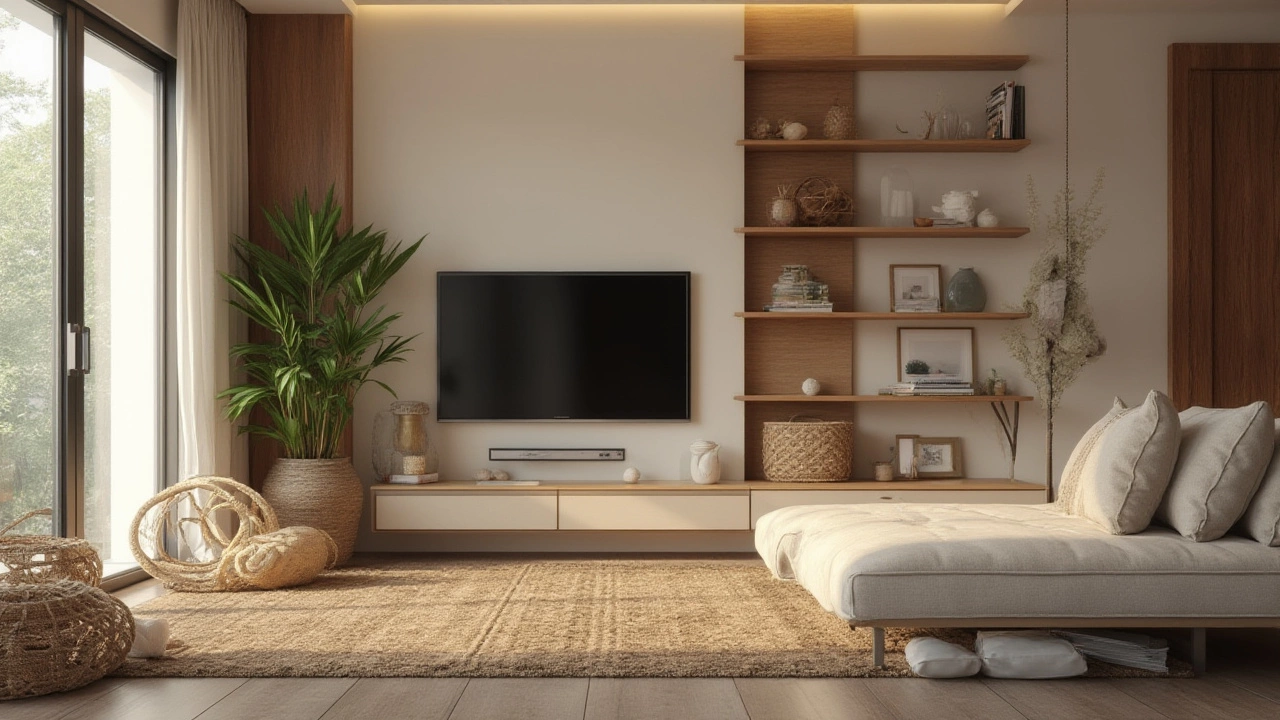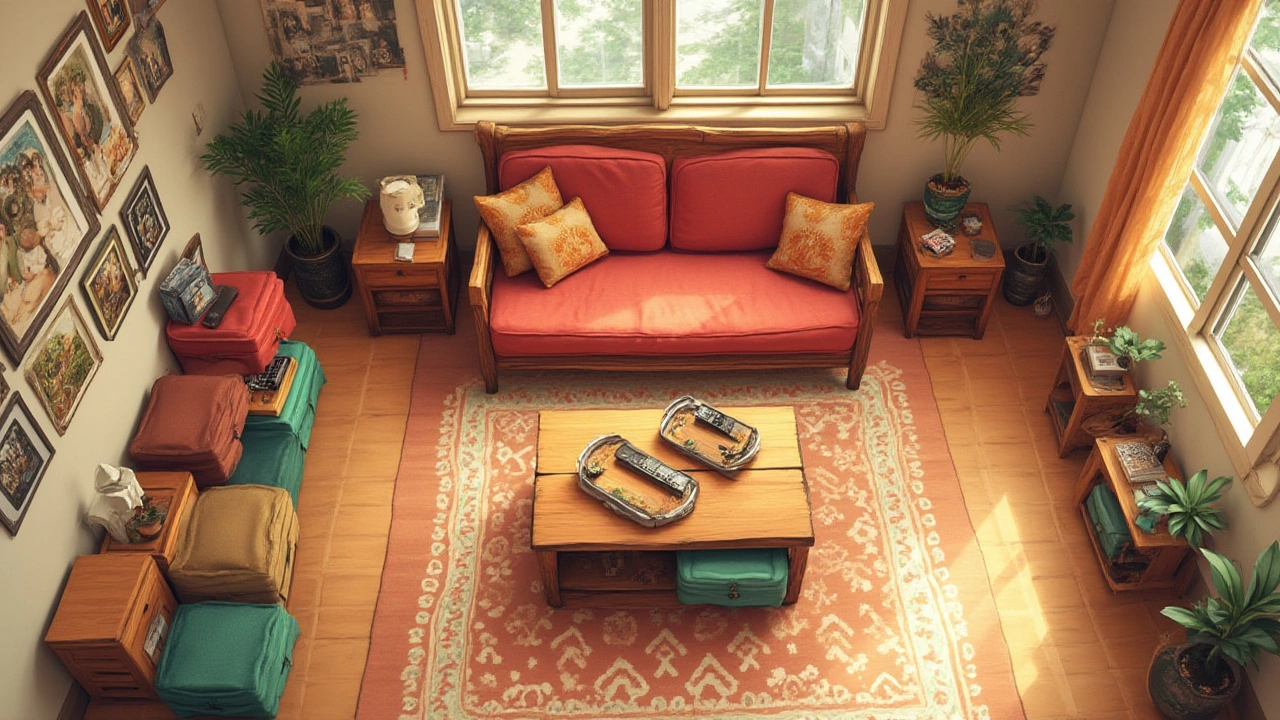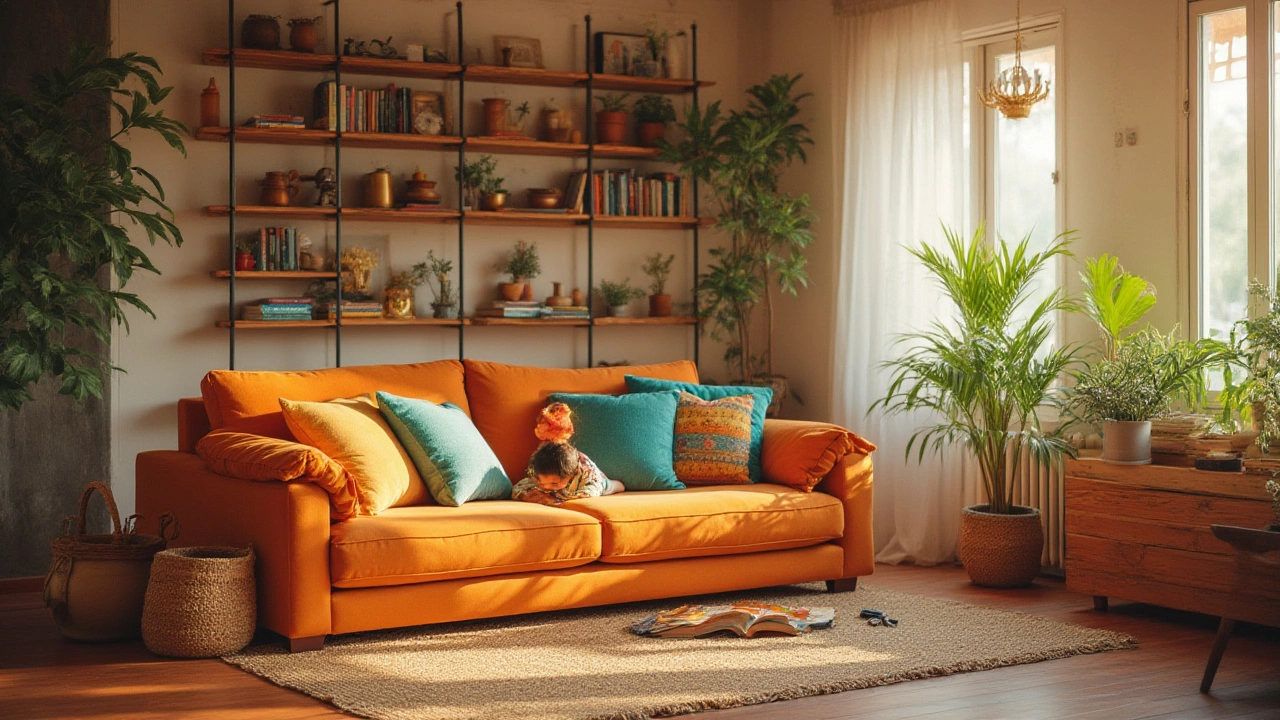Ever walk into someone’s living room and instantly feel at ease? Something about it just works: the furniture flows, it feels open but cozy, and you can actually see the coffee table—not just piles of yesterday’s socks. Achieving that magical balance isn’t just for design magazines. Even when you’ve got kids (like I do with wild little Cyrus and art-exploding Delphi), an inviting, organized living room is totally possible—and you don’t need buckets of money, just a few clever tricks and a fresh way of looking at your space.
Mastering Your Living Room Layout
Start here—the layout. That’s where the heart of an organized living room really starts pumping. There’s actually science behind why some spaces feel more relaxed. A 2020 study from the University of Otago found that clutter affects stress levels, focus, and even our ability to relax. So it's not just about neatness—how you arrange things changes how you live.
First, look at the room and think about what you really do in it. Family movie nights? Remote work? Birthday chaos with a half-dozen sweaty kids? Make a quick list. This helps you stop cramming in furniture that doesn’t serve your real life.
Getting the furniture placement right works like magic. Avoid pushing everything against the walls—surprisingly, pulling your sofa just 10-20cm away from the wall gives things breathing space and makes the room feel bigger. In Wellington, where rooms often aren’t gigantic, that little trick works wonders. If you don’t have a huge living room, try using a rug to define the seating area; that gives a sense of order without putting down extra walls. Rectangular rugs work best under sofas and armchairs. Make sure at least the front legs of all seating rest on the rug—designers swear by this because it locks everything together visually.
Traffic flow is key. Think about how people actually walk through your space. If folks have to step over a toy box to get to the sofa, rethink. Try to leave at least 80cm for walking paths where people move most—especially between doorways or into the kitchen. In homes with kids, low-slung storage units can help double as barriers that subtly guide little feet away from delicate stuff. Good flow makes a world of difference for relaxed hosting.
Don’t forget focal points. You need one thing for your eyes to land on—a fireplace, TV, bookshelf, even a cool piece of art. Orient your main seating to face this. The rest of the room falls into line if you get the center right. If you’re stuck with a weird space, floating furniture (setting your sofa at an angle or island-style in the middle of the room) sometimes works better than slavishly following the walls.
Now, about TV placement. Most people instinctively shove it against the biggest wall, but think it through. Avoid putting it facing windows—you’ll just get glare, or end up wrangling curtains daily. For the most comfortable viewing, the center of the screen should be at eye level when you’re seated (often around 105cm from the floor).
Feeling cramped? Skip the big coffee table and use two or three smaller side tables. They’re easier to move around, and you still have a spot for mugs and books. Sectionals look cozy in big rooms, but in tight city flats, try a regular sofa with an armchair or two for flexibility.
Got awkward corners? Pop a plant, a standing lamp, or even a stack of books there—otherwise, corners collect dust bunnies and random lost toys.
If you’ve got an open-plan living room with the kitchen right there, use shelving, a console table, or even a row of plants to “zone” the space. Dividers don’t have to be walls—they can be bookcases or even just color contrasts in your rugs or cushions.
| Living Room Size | Recommended Sofa Size | Recommended Rug Size |
|---|---|---|
| Small (under 15m²) | 180-210cm (2-3 seater) | 120x180cm |
| Medium (15-30m²) | 210-260cm (3-4 seater) | 160x230cm |
| Large (over 30m²) | 260-310cm (sectional) | 200x300cm or bigger |

Storage Solutions That Actually Work
Here’s the problem: living rooms are magnets for clutter. You clear one coffee table, and somehow it fills up right at bedtime (usually with a mess of Lego bricks in our house). Good storage is like a secret weapon against the madness.
First, baskets. I mean, honestly, probably 75% of our tidying involves chucking toys, chargers, or library books into baskets. Go for a few roomy, sturdy ones—wicker or canvas holds up best in real, messy homes. Slide them under coffee tables, benches, or beside the sofa. Bonus points: kids can help put stuff away when it’s this simple. Little baskets near the entrance swallow keys, sunglasses, remotes—anything that clutters flat surfaces.
Shelves—especially those that reach up to the ceiling—double your storage without eating floor space. Floating shelves look modern but don’t skimp on anchors; no one wants a shelf full of novels crashing down. Use lower sections for books and board games, higher shelves for stuff you barely use (like seasonal decorations or board game expansions gathering dust).
If you’ve got space behind the sofa, try a narrow console table. It makes a home for lamps, plants, or those endless drink bottles. Some even have hidden drawers, which are gold for stashing TV remotes and Mars Bar wrappers—my weakness after the kids go to bed. Ottoman coffee tables with lift-up lids offer stealthy storage for blankets and kid stuff, and kids won’t smoosh their fingers quite so much as with wood-top boxes.
Wall hooks for jackets, headphones, or handbags keep daily-use stuff off the floor. If you rent your place, try self-adhesive hooks—they hold up surprisingly well if you keep within the weight limits. Entryway benches with storage baskets underneath tame shoes and sports gear. Shoe racks with adjustable shelves let you fit everything from dad’s hiking boots to tiny gumboots.
Built-in joinery gives living rooms a “custom” feel, but if that’s out of reach, look for modular units from stores like IKEA or Mitre 10—they grow with your needs. If you go for closed cabinets, add labels or see-through bins inside so you don’t forget what’s where. No one wants to play hide-and-seek with a missing HDMI cable right before movie night.
Try setting up a 'drop zone' near the living room entrance. Ours is basically a basket for school bags and a “mail dump tray” that I try to empty once a week (try—busy dad, remember?). Pegboards or small magnetic whiteboards help keep school or shopping lists off the coffee table but still visible for family reminders.
For power cords (we all have way too many), a cable management box tucks away the spaghetti mess. Tape cords to the backside of consoles or use reusable twist ties—anything to get them off the floor so you’re not tripping over them mid-laundry-run.
If you’re dealing with heaps of toys, try a rotational system. We store about two-thirds of the toys in a hall cupboard and keep only a few baskets out at a time—suddenly, the kids notice their “old” toys again. This cuts clutter and makes it way easier to tidy up before guests arrive.
A quick cheat: set a timer for 5 minutes every night. Everyone grabs a basket, and you do a family junk sweep. Whoever finds the wildest item gets to pick the next Friday’s pizza topping—it turns the whole thing into a bit of a game. Little stuff like this adds up to a less chaotic space.
| Storage Solution | Best For | Where to Place |
|---|---|---|
| Large baskets | Toys, spare cushions | Beside sofa, under console table |
| Floating shelves | Books, small decor | Walls above sofa or TV |
| Console table | Remotes, lamps, keys | Behind sofa, entryway |
| Ottoman with lid | Blankets, board games | Center of seating area |
| Wall hooks | Bags, jackets, headphones | Near door or entryway |

Decor Tricks for a Cozy, Stylish Space
Here’s the fun bit: turning your living room from just tidy into something you’re proud to show off. Let’s start with color. Neutrals—light grey, beige, or soft greens and blues—open up a space, but don’t be afraid to add pops of color. A single vibrant cushion or a wild art print can make a room feel alive. If you want a moodier vibe, deep navy or charcoal walls can feel dramatic and snug (just add lighter accents to avoid the cave look).
Try the “rule of three” for styling—clusters of three items (vases, candles, ornaments) look less cluttered and more intentional than a crowd of smaller bits. On shelves, mix books stored horizontally and vertically; it’s a little design trick that keeps things from feeling too stiff.
Lighting changes everything. Instead of relying on just the overhead light, layer it up. A floor lamp in one corner, table lamps near armchairs, and maybe even some warm LED strips behind shelves make a world of difference. Adjustable brightness means no more squinting during board games, but you can also dim it for movie nights or cozy reads. A study out of Massey University in 2022 showed room lighting impacted mood by up to 23%. Swap any harsh white bulbs for warm (2700K-3000K) for great results.
Plants do wonders. Even one or two (real or decent fakes) add life and scrub the air. Sansevieria (snake plant), pothos, or monstera thrive with minimal attention, perfect if you’ve got a packed schedule. In Wellington’s sometimes-moody weather, a couple of leafy mates near the window can make a day indoors feel way less dreary.
Mirrors are another not-so-secret decorator trick. Hang a decent-sized one opposite a window, and your room feels instantly bigger. You get more light bouncing around, too, which helps especially if your living room’s a little on the dark side (basically every home I had before kids).
Don’t be scared to mix textures: soft wool throws, chunky knit cushions, smooth glass, or even a battered leather footstool. Texture keeps a living room feeling comfy and relatable rather than showroom-sterile. Let your kids’ art take pride of place; in our house, a rotating picture frame means Delphi's latest masterpiece always gets a spot on the wall—guests love it, and it gives the place personality.
If you hate mess but still want personality, try wall-mounted shelves for family photos, or a single ‘gallery wall’—just keep the frames the same color for a cleaner look. Add one quirky or conversation-starting piece: a vintage lamp, a weird sculpture, or a travel souvenir makes a space feel truly yours.
Finally, the best decor tip? Let your living room breathe. Don’t fill every surface. Negative space—empty spots on shelves or the floor—is as important as the stuff you put in. This makes the whole room feel calmer, brighter, and more welcoming.
Pulling this all together, organizing your living room into something that actually works and feels personal is more about smart choices than fancy spending. The best spaces focus on what people actually need—family, friends, a soft spot to flop after work. Get the organize living room basics right, play with storage and personalize with things that make you smile, and you’ll never dread the word “tidy up” again. Even on days when a volcano of toys erupts and the biscuits get ground into the rug, you’ve got a plan to bring back order—and a little joy—every time.

